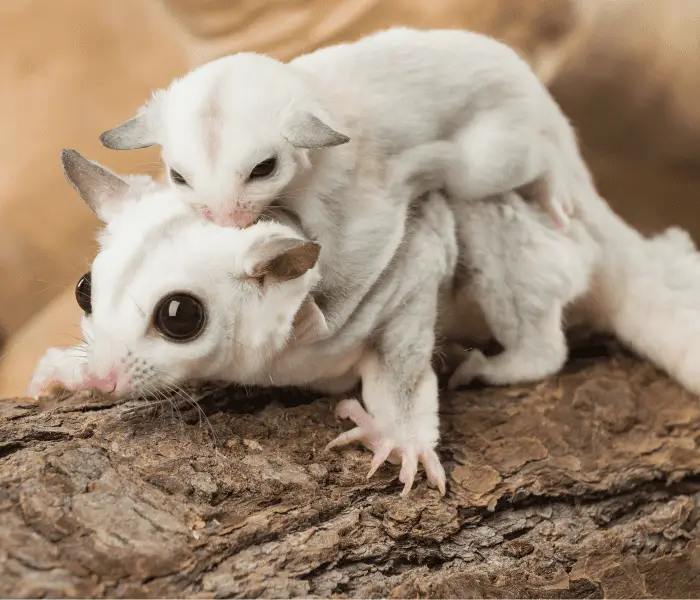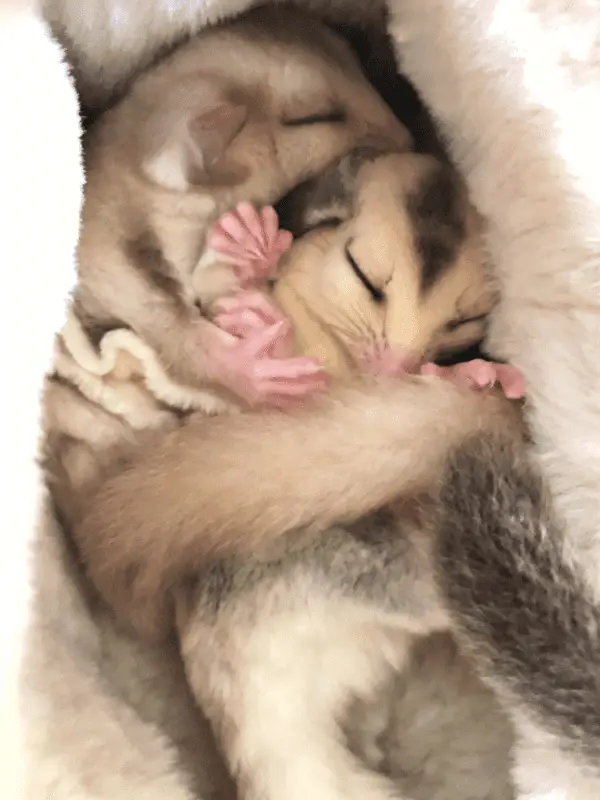
Although cute and cuddly, it is essential to remember that pet sugar gliders are still wild animals. They still act upon their natural instinct, and sometimes, as cruel as it seems, sugar gliders will eat their young. This article explains some of the reasons for this phenomenon as well as ways to prevent infanticide in sugar gliders.
There are various reasons why a sugar glider may sometimes kill and cannibalize her young (joeys). The lack of resources, poor maternal instinct, environmental stress, pouch infection, and congenital disease of her offspring are some of the most common reasons for a sugar glider to cannibalize her joey.
It is horrifying and disheartening to find that your sugar glider has killed her joey, and anyone who has ever come across this scene will want to do everything to avoid the same from happening again, but in order to know how to prevent infanticide, we will first need to understand the possible causes.
Cannibalism In Sugar Gliders
Cannibalism is an ecological interaction that exists in the wild across many species in the animal kingdom. The purpose of cannibalizing is to rid their living space of evidence that might attract predators and to keep the colony “clean”.
Ridding the colony of carcasses may aid in eliminating a disease or genetic defect from the colony.
In the case of disease, the colony might still be affected; however, it will ensure the survival of other colonies by having the disease contained within one and not spread to other surrounding colonies. This is observed in wild colonies and is not often an occurrence in pet sugar gliders, but it gives some context as to why cannibalism occurs.
Pet Vet Tip: To read more on cannibalism in sugar gliders, have a look at this article.
Reasons For Infanticide In Sugar Gliders:
1. Food Scarcity Or Limited Nesting Space (Limited Resources)
Good nutrition is an essential part of ensuring successful breeding, parturition, and caring for the young. Luckily, your pregnant or carrying sugar glider’s appetite may not change considerably, and it might not be necessary to provide food for two, per se.
Sugar gliders do, however, have specific dietary needs that are vital for not only their survival and well-being but that of their offspring as well. Provide your breeding sugar glider with a balanced diet rich in protein and calcium. This can also help prevent conditions like agalactia, discussed below.
Pet Vet Tip: For more information on sugar glider diet, and example meal plans, check out this resource on our website. You may also find the article on calcium deficiency in sugar gliders helpfull.
Lack of space for your sugar gliders induces stress, and they end up competing for space. A sugar glider may cannibalize her joey for this reason, and so it is necessary to make sure your housing facility for your sugar glider is large enough for the current gliders and the potential gliders that may come along in the future.
Pet Vet Tip: The article on Sugar glider social structure provides more helpful information on the ideal number of sugar gliders to be kept together.
2. Poor Maternal Instinct
Sugar gliders are instinctively good parents. However, some are not so good at parenting their joeys. While some female sugar gliders will protect and tend to her joeys despite losing condition or feeling threatened, other female sugar gliders will stop caring for her joeys the moment a stressor is introduced.
This seems to be a genetic trait of individual gliders, and females with poor maternal instincts should not be used for breeding in the future.
3. Pouch infection
Pouch infections, similar to mastitis, are not always obvious. The most common symptom sugar glider owners notice is a discharge our foul smell from the pouch. Joeys may detach from the nipple or climb out of the pouch. This often leads to dehydration and weight loss of the joeys, which puts them at risk of infanticide.
Pouch infection can be life-threatening to the dam if not treated appropriately, and veterinary care should be sought as soon as possible if you suspect that your sugar glider may be suffering from a pouch infection.
4. Mastitis
Inflammation of the breast tissue eventually leads to infection. This disease is rare in sugar gliders but can occur in females who are nursing or weaning their joeys. Joeys are permanently attached to the teat within the pouch and may become ill and die from ingesting infected milk or from the antibiotics to treat the dam.
Mastitis causes redness and swelling of the teat and surrounding tissue, but this is not easily seen as the pouch needs to be everted in order to visualize the nipple. If you are worried that your sugar glider has mastitis, it is best to consult an exotic pet veterinarian.
5. Agalactia Or Hypogalactia (No or Insufficient Milk Production)
Nutritional deficiencies are usually the culprit that leads to poor milk production. And similar to mastitis, this condition is not easily diagnosed, but weight loss and dehydration of the joeys are usually good indications that milk production may not be sufficient.
Once joeys are weak or dehydrated, they are at risk of being cannibalized by the dam. Again, if you suspect this, it is best to consult your vet as soon as possible.
6. Environmental Stress
A sugar glider’s instinct makes them prone to stress as pets. A stressed sugar glider may self-mutilate, but it may also turn on its colony members and even its joey.
Parturition (giving birth) and carrying young is a stressful and vulnerable times for all animals. For this reason, any females that you suspect may be pregnant or carrying joeys should be disturbed as little as possible, and all potential stressors should be avoided.
Pet Vet Tip: For Tips on how to calm a stressed pet sugar gliders as well as a list of potential stressors, and signs how you can tell that your sugar glider is happy, have a look at the linked articles on our website.
It is also advisable not to upset the social structure of the sugar gliders during this time by adding, removing colony members, moving the dam, or attempting to touch the joey in the pouch. Joeys are attached to a nipple inside their mother’s pouch for about two months before coming to the outside world. You should never interfere with a joey in pouch unless absolutely necessary.
Most male sugar gliders are accepting of healthy joeys, and it is therefore not recommended to remove male sugar gliders from the enclosure unless aggression towards the dam carrying joeys is noted.
Keep your sugar glider’s routine and the external environment the same after breeding until the babies are wholly weaned to minimize stress and subsequent cannibalism.
7. Congenital Defects Of The Young
Joeys with congenital defects have little to no chance of survival in the wild. Congenital defects, sickness, or injury are seen as vulnerability to the colony. The sad reality is that weak colony members attract predators and are an unwanted burden on colony resources. For this reason, a sugar glider will cannibalize her joey to ensure the safety and survival of the rest of the colony.
What Can I Do To Prevent My Sugar Glider From Killing Her Joey?
- Increase the space for a growing colony.
- Provide a nutritious and balanced diet. Some special formulations for sugar gliders provide all the necessary nutrients for the health and well-being of your sugar glider.
- Consult with your veterinarian on how to handle and what to do with your sugar glider at this precious time.
- Keep a consistent routine during the breeding – feed and clean the cage per the usual schedule.
- Minimize stress factors, such as unexpected, loud noises or the presence of other animals, by having the sugar glider cage in a separate room behind a closed door
Pet Vet Tip: Read this article if you would like to learn more about the intersting facts and common questions on female sugar glider reproduction.

Final Thoughts
Infanticide is instinctual behavior to protect the colony. The reasons for infanticide are numerous, and it can be hard to denote the exact cause in all cases. The best you can do to prevent infanticide in a pet sugar glider colony is to ensure that the colony is well-fed and have minimal stressors.
Resources
- Banks, R., 2013. Exotic small mammal care and husbandry. Hoboken: John Wiley, pp. 157 – 168.
- Burgess, M.E. and Bishop, C.R. (2012). Reproductive Physiology, Normal Neonatology, and Neonatal Disorders of Sugar Gliders. In Management of Pregnant and Neonatal Dogs, Cats, and Exotic Pets, C. Lopate (Ed.). https://doi.org/10.1002/9781118997215.ch17
- Meredith, A. and Redrobe, S., 2002. BSAVA manual of exotic pets. 4th ed. Quedgeley: British Small Animal Veterinary Association, pp. 102 – 106 25.
- Saunders, R. (2015, April). What is a sugar glider and how do I nurse it?. In BSAVA Congress Proceedings 2015 (pp. 372-373). BSAVA Library
- Tynes, V., n.d. Behavior of Exotic Pets. Wiley-Blackwell, pp.181-189.

